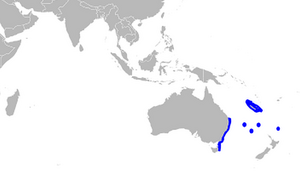Dumb gulper shark facts for kids
Quick facts for kids Dumb gulper shark |
|
|---|---|
 |
|
| Conservation status | |
| Scientific classification | |
| Genus: |
Centrophorus
|
| Species: |
harrissoni
|
 |
|
| Range of dumb gulper shark (in blue) | |
The dumb gulper shark (Centrophorus harrissoni) is a rare and endangered deep-sea dogfish. It lives mainly along the east coast of Australia. You can also find it in a few spots north and west of New Zealand. People sometimes call it the dumb shark or Harrison's deep-sea dogfish.
Contents
What Does It Look Like?
The dumb gulper shark can grow up to about 109 cm (43 in) long. It has a strong, long head and a flat snout. Its mouth is large, and its eyes are big and green. These special eyes help it see in the deep ocean, about 250 to 385 meters (820 to 1260 ft) down.
Its body is slender and medium-sized. It's usually grey or brownish-grey on top and lighter underneath. It has two fins on its back, called dorsal fins. The first one is bigger than the second. Both dorsal fins have a short spine and a white edge at the back. They also have a dark spot near the front, which is easier to see on younger sharks. Its tail fin is large and not even, with the top part being longer than the bottom.
The shark's teeth are wide and different in its upper and lower jaws. The lower teeth are much bigger. Also, male and female sharks have different teeth. Males have straighter upper teeth and lower teeth that curve upwards. This shark looks very much like its close relative, the little gulper shark.
Where Does It Live?
You can find this shark off the east coast of Australia. This includes areas like New South Wales, Victoria, Queensland, and Tasmania. It also lives off the coast of New Zealand. It prefers to live near the ocean floor on the upper and middle parts of the continental slope. This is the area where the land drops off into the deep ocean.
What Does It Eat and How Does It Live?
Dumb gulper sharks mostly eat other fish, especially lanternfish. They also enjoy eating squid and crabs.
Female sharks usually have only one or two babies every one to two years. They can live for a long time, often up to 46 years on average.
Why Are There So Few?
We don't know exactly how many dumb gulper sharks there are. But their numbers have dropped a lot, by as much as 99% in some places since the 1970s.
People catch these sharks for their meat and for oil from their liver. This oil is called squalene. Sharks that live higher up on the continental slope are easier to catch than those living deeper. This is because they are hunted across most of their living area.
These sharks have a low birth rate, mature slowly, and live a long time. This means they cannot recover quickly once their numbers go down.
How Are We Protecting Them?
Efforts are being made to protect the dumb gulper shark. In Australia, it's part of the Environmental Protection and Biodiversity Conservation (EPBC) Act. This act helps create plans to keep the species safe.
To help the shark's population grow, rules have been put in place. These include limits on how many sharks can be caught and closing certain fishing areas in southern Australian waters.
In New Zealand, the Department of Conservation has listed the dumb gulper shark as "Data Deficient." This means there isn't enough information about its population there. However, they also note it is "Threatened Overseas," recognizing its endangered status in other parts of the world.
See also
 In Spanish: Quelvacho mudo para niños
In Spanish: Quelvacho mudo para niños


